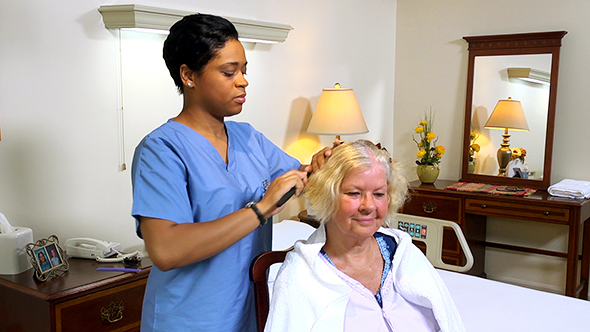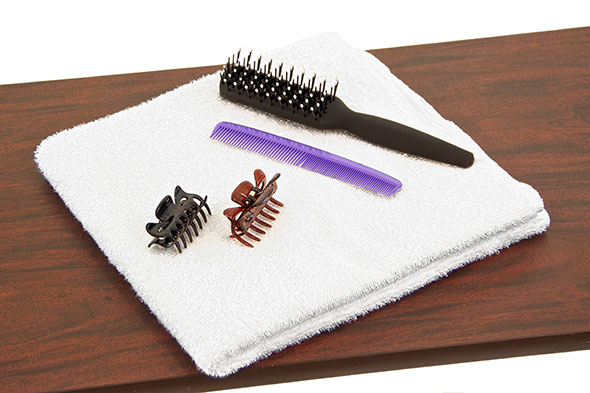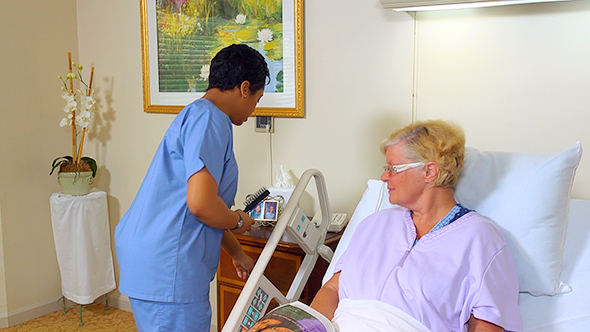Personal Hygiene and Grooming
Select a Skill:
- » Performing Oral Hygiene
- » Providing Denture Care
- » Brushing and Combing the Person's Hair
- » Shampooing the Person's Hair
- » Shaving the Person's Face
- » Giving Nail and Foot Care
- » Assisting with Undressing and Dressing
- » Changing the Gown of the Person with an IV
Take the Review Test:

Purpose

- The look and feel of hair affect the person’s mental well-being.
- Brushing and combing hair are part of early morning, morning, and afternoon care. Some people also do it at bedtime. Provide hair care whenever needed and before visitors arrive.
- Encourage people to do their own hair care. Assist as needed. The person chooses how to brush, comb, and style hair.
- Brushing increases blood flow to the scalp and moves scalp oils along the hair shaft.
- For long hair, daily brushing and combing also prevent tangling and matting. So does braiding. You need the person’s consent to braid hair. Never cut the person’s hair.
- Special measures are needed for curly, coarse, and dry hair. The person may have certain hair care practices and products. They are part of the care plan. Also, let the person guide you when giving hair care.
Equipment
Roll cursor over items to see labels. For the purposes of clearly depicting the equipment, a barrier is not shown in this photo. When providing care, a barrier should always be placed on the surface before placing the equipment.

Bath towel
Comb and brush
Hair clips
Delegation
- Follow delegation guidelines. Before brushing and combing the person’s hair, obtain this information from the nurse and care plan:
- How much help the person needs
- What to do for matted or tangled hair
- What to do for curly, coarse, or dry hair
- What hair care products to use
- The person’s preferences and routine hair care measures
- What observations to report and record
- When to report observations
- What patient or resident concerns to report at once
Preparation

- Observe quality-of-life measures.
- Review the information under Delegation and Safety and Comfort.
- Practice hand hygiene.
- Identify the person. Check the ID bracelet against the assignment sheet. Also call the person by name.
- Ask the person how to style hair.
- Collect the items needed for hair care.
- Arrange items on the bedside stand.
- Provide for privacy
Safety

- Sharp bristle brushes can injure the scalp. So can a comb with sharp or broken teeth. Report any concerns about the person’s brush or comb.
Comfort
- Place a towel across the person’s back and shoulders to protect garments from falling hair.
- If the person is in bed, give hair care before changing linens and the pillowcase. If done after a linen change, place a towel across the pillow to collect falling hair.
Procedure Video
Audio Description: OFFFollow-up Care

- Provide for comfort.
- Place the call light within reach.
- Lower the bed to its lowest position. Raise or lower bed rails. Follow the care plan.
- Clean and return hair care items to their proper place.
- Unscreen the person.
- Complete a safety check of the room.
- Follow agency policy for dirty linens.
- Practice hand hygiene.
Reporting/Recording
- Report and record your observations, including:
- Scalp sores, rash, flaking, or itching
- Patches of hair loss or hair falling out in patches
- Very dry or very oily hair
- Matted or tangled hair
- The presence of nits or lice
- Irritability
- Complaints of a tickling feeling or something moving in the hair
Review Questions
Select the best answer.
1. What is a purpose of brushing and combing the person’s hair?
 To prevent head lice
To prevent head lice To promote mental well-being
To promote mental well-being To remove bacteria from the hair
To remove bacteria from the hair To stimulate circulation to the hair shaft
To stimulate circulation to the hair shaft
Select the best answer.
2. When brushing and combing the hair, which action helps promote safety?
 Report sharp bristles on a brush or teeth on a comb
Report sharp bristles on a brush or teeth on a comb Always wear gloves when brushing or combing the hair
Always wear gloves when brushing or combing the hair Cover the person’s eyes with a towel during brushing or combing
Cover the person’s eyes with a towel during brushing or combing Avoid using any hair care products that the person brings from home
Avoid using any hair care products that the person brings from home
Select the best answer.
3. How should you expect to position a person who remains in bed for hair brushing and combing?
Select the best answer.
4. To brush or comb hair that is tangled, what should you do?
 Cut out the tangle. Then brush or comb as usual
Cut out the tangle. Then brush or comb as usual Work in small sections from the ends to the scalp
Work in small sections from the ends to the scalp Use a brush with sharp bristles or a comb with sharp teeth
Use a brush with sharp bristles or a comb with sharp teeth Part the hair down the middle into two sides and comb through
Part the hair down the middle into two sides and comb through
Select the best answer.
5. Which observation should you report as a possible sign of head lice?
You have completed the Review Questions for this skill. To take the Review again select the Start Over button. To proceed to another skill select from the dropdown menu. Select the Home or Back button to proceed to the next section.

